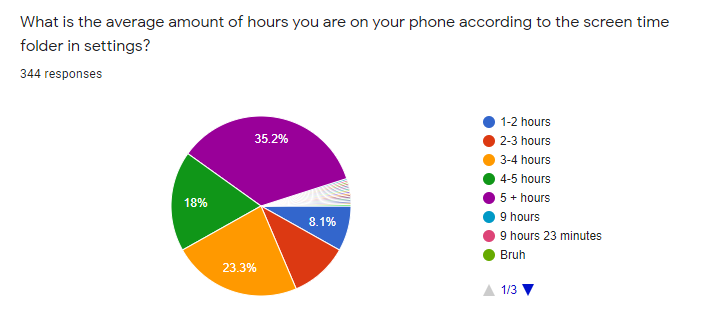Gen-Z: The Generation of Screens
With social media becoming the most prominent form of entertainment, children and teenagers struggle to keep their imaginations active, being focused on what is on their screens.
The first thing we look at in the morning, the last thing we see before our head hits the pillow at night: our screens are consuming our everyday lives.
It’s no secret that in this generation, everyone is constantly on their phones. But just how much are we really glued to our screens? Between being in school all day, going to extracurricular activities and sports practices, and trying to keep a healthy sleep schedule, there isn’t that much free time to be on technology in a high schoolers day… right?
Wrong. As soon as we wake up, right before we go to sleep, the time between classes, sneaking looks during classes, on the bus, in the car: our whole day is consumed by screen time, and that screen time adds up.
What is Screen Time?
As a part of iOS 12 in 2018, Apple released a screen time feature with the intention to give parents access to controlling their child’s screen time. If turned on, this feature allows Apple users to access their personalized average screen time per day and week, total screen time per day and week, most used apps, and the increase or decrease of the users screen time from the previous week.
In addition to access to screen time information, this feature also shows information about phone pickups and notifications. It shows how many times a user picks up their phone over the course of a day or week, and also how many notifications the user receives over the course of a day or week, as well as their averages.
How Do Screens Affect Us
A young person’s brain does not have time to develop a fully-functioning self-control system to stop the obsessive behavior associated with social media. As a result, they find themselves addicted to their phones before realizing the consequences.
Due to their obsession, a lot of the teenagers are staying awake in favor of using technology, causing them to not only get less sleep, but eventually begin to lack the deep sleep needed for processing and storing information of day-to-day memory.
Children and teenagers need to spend their time both online and offline, allowing the ability to let their minds wander to form. Boredom causes a necessity for creativity and imagination. However, with social media becoming the most prominent form of entertainment, children and teenagers struggle to keep their imaginations active, being focused on what is on their screens.
When it comes to our screens, vision has been a long time concern from parents and other adults regarding technology’s effect on people’s health. When people use technology, they blink half as much as normal, leading to dry eyes and a constant strain.
Some people experience worse symptoms, including blurry vision, irritation, heavy or tired eyes, and even tears from looking at their devices for too long. After a while, these symptoms can cause long-term eye strain, headaches, and stress that will worsen over time just because of the constant irritation.
If you are worried about adverse health effects, researchers suggest taking regular breaks from one’s phone, any amount of time helps.
If you find yourself tossing and turning at night, screen time might be the culprit. Spending too long on technology can create problems with sleep schedules, leading to sleep deprivation.
A study from Harvard University found that the blue light emitted by our phone screens can disrupt our circadian rhythm, or sleep patterns, by suppressing melatonin secretion in our bodies. This suppression of melatonin can cause insomnia when trying to fall asleep at night.
All this screen time is also having an effect on people’s face to face interactions. Before technology, if you needed to talk to someone, you spoke face to face. Now, you can easily speak to anyone right at your fingertips. While this accessible form of communication can be seen as simple and painless, it’s ruining this generation’s social skills.
It is now common for a group of friends to spend time with each other, just for the group to avoid eye contact. It has become too common for groups of friends, sitting right across from one another, to be glued to their phones, no longer socializing with one another. Socialization often takes place through a screen, taking the place of once-valued face to face interaction.
Furthermore, the excessive time spent on phones can cause self-confidence to plummet. Most teenagers spend time on their phones looking at social media. Seeing social media posts from one’s peers or from lavish celebrities can cause unrealistic comparison and burning jealousy. These toxic feelings can cause social media users to self-loathe.
Screen Time Statistics
Compiling data from 25 high school students of all ages, it’s evident that screen time plays a massive part in our everyday lives. The average screen time of a high school student is 6 hours a day, but times ranging as low as 2 hours a day and as high as 13 hours a day.
With the weekly screen time statistics, one student spent 94 hours and 48 minutes on his phone, spending 80 hours and 54 minutes on entertainment, 4 hours and 6 minutes on social networking, and 2 hours and 24 minutes on games.
The screen time feature tracks which applications are used most by the user. The feature also shows how long, on average, the user spends on specific applications. Apps like Snapchat, TikTok, Netflix, Instagram, Youtube, and Twitter have the highest usage amongst teens.
Instagram takes credit for many of these teenanger’s high averages. One student reports spending over 15 hours on the platform.
TikTok, in particular, has an overwhelming amount of usage amongst teens. One individual from the study admits more than 18 hours of screen time in one week on TikTok.
Screen Time Limitations
Because of all of the downsides to excessive screen time, Apple made it possible to set limitations on how long a users phone will allow them to be looking at their screen in a day. Setting time limits can increase a users productivity, help their sleep schedule, make them more social, and keep them engaged in the world surrounding them.
However, some students are either unaware that the limitations feature exists, or choose not to use this feature in fear that they won’t be able to abide by their limitations.
Junior Bridget McCourt does not use limitations simply because she is able to monitor her screen time without the specific feature engaged. “I knew they [limitations] existed, but I’m pretty good at just getting off my phone so I don’t use them,” she said.
Junior Emma Zykh chooses not to use the limitations for a similar reason. “I like to think that I am responsible enough to balance out my phone time with my other priorities,” Zykh said.
However, she admits that she gets distracted by her phone very frequently. “I’ve caught myself getting very off track because of a notification or a snapchat from someone,” she said.
Zykh used to have to put her phone on the kitchen counter when she was doing homework upstairs, but she does not anymore; she has since learned how to manage her time better. Instead of putting her phone downstairs, she now puts her phone on a setting called ‘Do Not Disturb’. This setting makes any incoming notifications silent until the setting is turned off, therefore keeping her on task without being distracted by her phone.
Freshman Elena Romero also has “no limits” on her phone. “I don’t spend much time on my phone, I usually spend my time talking with my mom or nieces,” Romero said.
She admits that every once in a while she catches herself on her phone for a long time scrolling through TikToks and posts on Instagram, but she feels most of the time, she can keep this impulse under control.
Final Thoughts
This generation has grown up with screens all around us, consuming our everyday lives. Although people are aware of the downsides to technology, people are constantly checking their phones rather than interacting with the world around them.
Screens distract users from getting tasks done. They damage users’ eyes and brains and can affect their sleep schedules. These little screens have made an entire generation antisocial. Yet this generation can’t seem to put them down.
Gen Z is a technological age: an era of FaceTime rather than face to face, of Snapchat rather than “real chat,” and of phone screens rather than the real world surrounding us.







